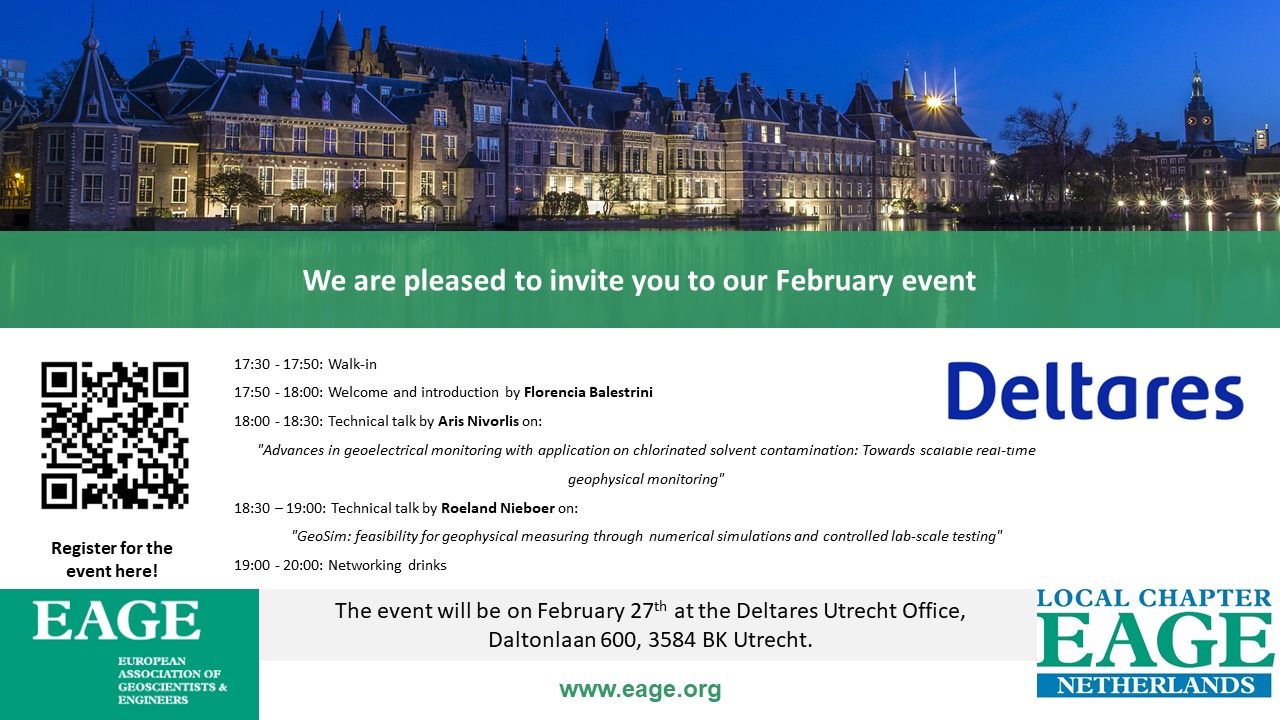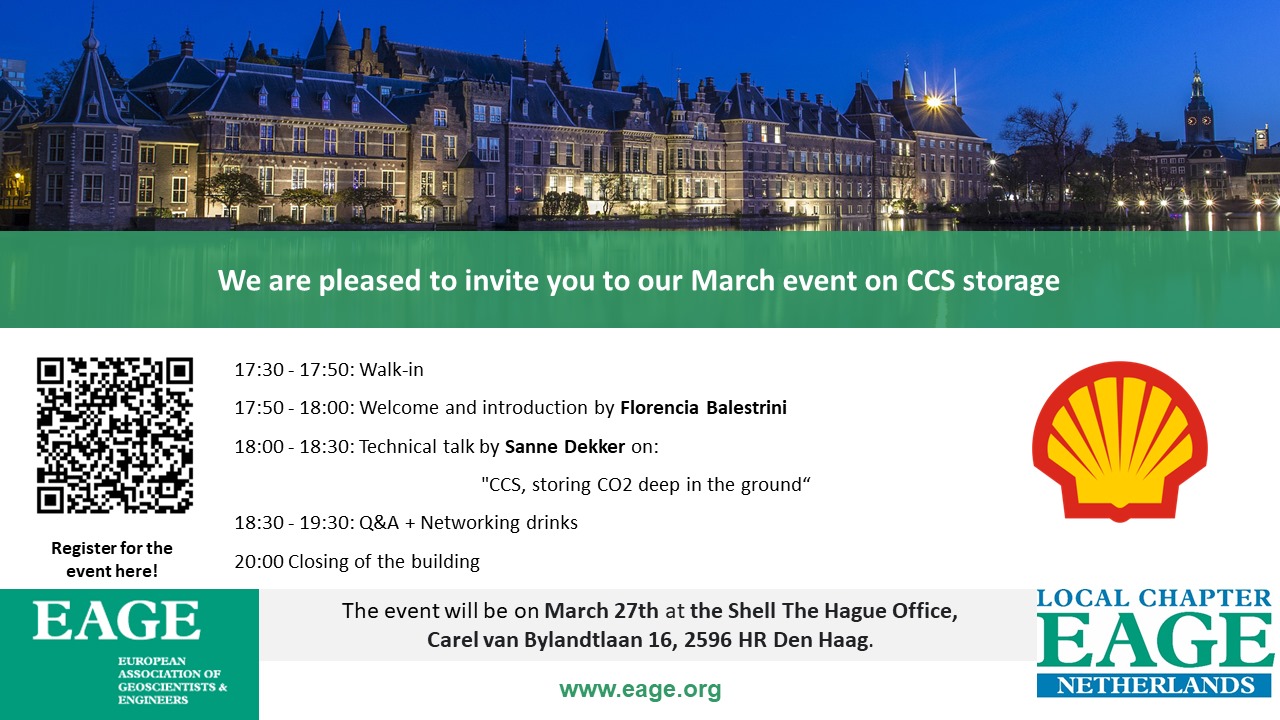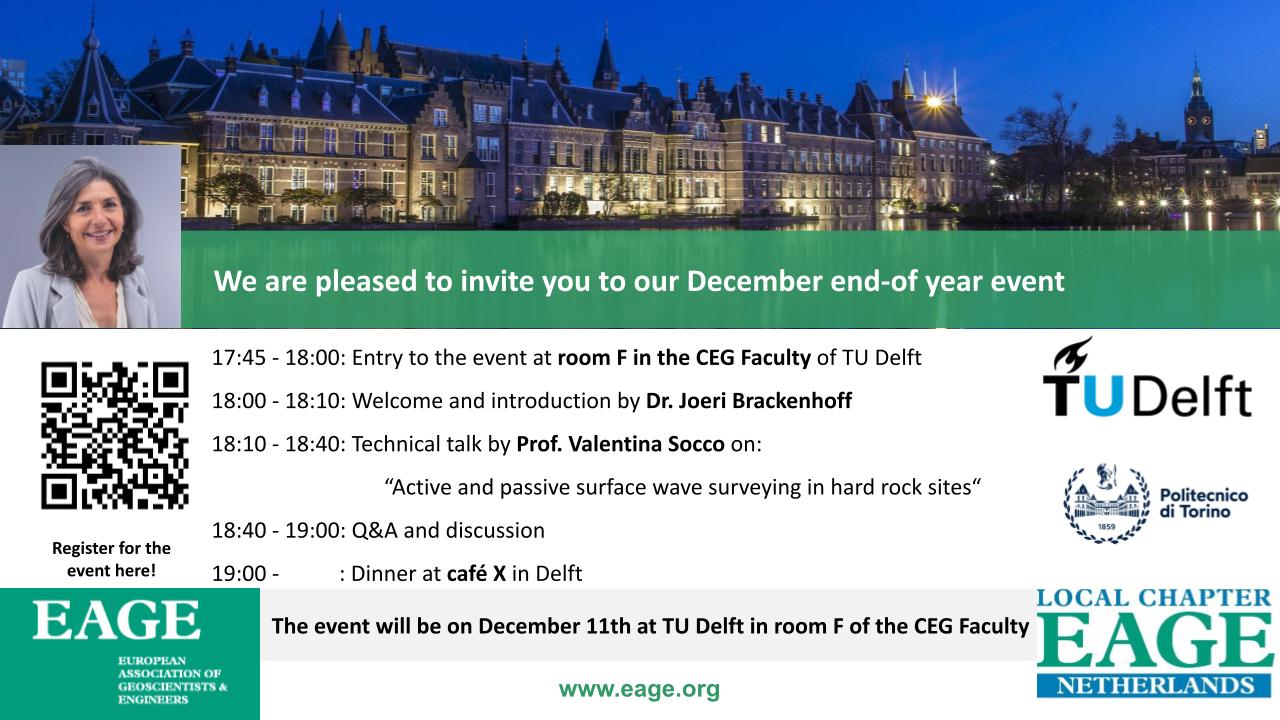February event:
Geophysical Monitoring
Information:
Our February event was organized in collaboration with Deltares
Agenda:
17:30 - 17:50 - Walk-in
17:50 - 18:00 - Welcome and short introduction by Florencia Balestrini
18:00 - 18:30 - Technical talk by Aris Nivorlis (Deltares) on:
Advances in geoelectrical monitoring with application on chlorinated solvent contamination: Towards scalable real-time geophysical monitoring
18:30 - 19:00 - Technical talk by Roland Nieboer (Deltares) on:
GeoSim: feasibility for geophysical measuring through numerical simulations and controlled lab-scale testing
19:00 - 20:00 - Networking drinks
Abstract:
Adapting urban areas to the current demands of
the energy transition, as well as maintaining crucial infrastructures like
roads, bridges and quay walls, requires large investments for which understanding
of the subsurface is vital. In this study, an urban environment
was created in a scaled lab environment to test a multi-sensor geophysical
setup. The lab setup included a brick top layer, different soil types and
buried, leaking pipelines. Co-located electrical resistivity, seismic and
ground radar measurements were conducted while varying the hydrological
conditions as well as simulating a leakage from a pipeline. Where the ground radar data most clearly
delineated boundaries between different elements in the subsurface, the
electrical resistivity and refraction tomography provided material parameters,
though detection of small features like pipelines was not possible. The leakage
of the pipeline was clearly detected by monitoring the electrical resistivity
and, to a lesser extent through reflections of the leakage front in the ground
radar data. The acquired data from this study is a good starting point for
joint-inversion and data fusion, that is expected to yield more useful
information about the sub-surface than each of the individual sensors by
itself.
Speaker: Roeland Nieboer (Deltares)
Biography:
Roeland Nieboer is an applied research geophysicist focusing on extracting soil and rock properties from integrated geophysical and geotechnical data. He is skilled in processing, interpreting, and analyzing data to derive insights into subsurface structures and properties.

March event:
Carbon Capture Storage
Information:
Our March event was organized in collaboration with Shell
Agenda:
17:30 - 17:50 - Walk-in
17:50 - 18:00 - Welcome and short introduction by Florencia Balestrini
18:00 - 18:30 - Technical talk by Sanne Dekker (Shell) on:
CCS: storing CO2 deep in the ground
18:30 - 19:00 - Q&A
19:00 - 20:00 - Networking drinks
20:00 - Closing of the building
Abstract:
During my talk (title CCS: storing CO2 deep in the ground) I
will explain the basic principles of CO2 storage, the subsurface challenges and
a bit about the project I am working on in the Netherlands.
Speaker: Sanne Dekker (Shell)
Biography:
My name is Sanne Dekker, I am Dutch, I have a French husband and we have three children, all born in New Zealand. A long time ago I studied Applied Earth Sciences (at that time called “Mijnbouw”) in Delft, specializing in geophysics. For more than 20 years, I have worked as a geoscientist for Shell in the UK (London and Aberdeen), New Zealand, Oman and the Netherlands in Exploration, Development and more recently in CCS (Carbon Capture and Storage). Besides work, I enjoy doing sports, travelling, photography and playing the piano.

Upcoming December event:
Active and passive surface wave surveying in hard rock sites
Information:
Our February event will be organized with sponsoring from EAGE
Date: December 11th, 17:45-22:00
Venue: TU Delft Room F, CEG Faculty, Stevinweg 1, 2628CN, Delft
Registration via Google forms
Agenda:
17:45 - 18:00 - Entry to the event at room F in the CEG Faculty of TU Delft
18:00 - 18:10 - Welcome and introduction by Dr. Joeri Brackenhoff
18:10 - 18:40 - Technical talk by Prof. Valentina Socco (TU Delft; Politecnico di Torino) on:
Active and passive surface wave surveying in hard rock sites
18:40 - 19:00 - Q&A and Discussion
19:00 - 20:00 - Dinner at café X in Delft
Abstract:
Surface waves data can be retrieved by any seismic records acquired for active and passive exploration purposes with whatever receiver layout and exploiting both active sources and ambient noise.
In hard rock sites, which are typical in mineral exploration, the data quality can be critical, but the high velocities of the formations generate long wavelengths that allow large investigation depth to be reached.
With appropriate processing and inversion workflows that include the application of interferometry and surface wave tomography 2D and 3D S- and P-wave velocity models can be estimated.
A series of case studies using active sources, traffic induced noise and ambient noise will be shown and methodological aspects related to optimal receiver layout and processing strategies will be discussed.
Speaker: Valentina Socco (TU Delft; Politecnico di Torino)
Biography:
Laura Valentina Socco, is presently Full Professor in Applied Geophysics at Tu Deflt and at Politecnico di Torino.
Prof. Socco works on developing geophysical techniques for near surface investigation in applications ranging from, seismic hazard and engineering, to hydrocarbon and mineral exploration, environment and cultural heritage.
In the last twenty years, she has focused her research work on surveying techniques based on the propagation of seismic surface waves for estimating subsurface velocity models and on geophysical data integration techniques.
In 2013 Prof Socco has been chosen as Honorary Lecturer by the SEG.
In 2014 she has received the Conrad Schlumberger Award (EAGE).
In 2019 Prof Socco has received the Outstanding Educator Award from SEG.
She has been Editor in Chief of Geophysics from 2017 to 2019.
She is presently EAGE President.
Prof. Socco is author of more than 150 scientific publications in peer reviewed journals and conferences.
She has been awarded with a honourable mention in the category best paper in Geophysics in 2012, 2013 and 2016.
She has been chair-person of the Near Surface Division Committee of EAGE and member of EAGE Board (2014-16).
She has been Associate Editor (2003-2013) Assistant Editor (2013-2017) of Geophysics and she has been Associate Editor (2006-2013) of Near Surface Geophysics.
